Dota 2 DPC Changes: Key Updates Impacting the Competitive Scene
Updated On: November 29, 2025 by Aaron Connolly
Major DPC Changes and Announcements
Valve ended the Dota Pro Circuit after the 2023 season. This move stands out as the biggest shakeup in competitive Dota 2 history.
Throughout 2023, Valve rolled out some pretty significant rule changes and structural updates. Then, they just pulled the plug on the whole system.
Valve’s Decision to End the Dota Pro Circuit
Valve dropped the news about ending the DPC in September 2023. That announcement closed the book on a system that shaped pro Dota 2 for years.
They made this call after a lot of people started questioning how well the circuit actually worked.
Why did Valve end the DPC?
- Cut down the heavy workload on teams and players
- Let tournament organisers get creative again
- Make the qualification process for The International more transparent
- Fix the problems with the rigid league structure
Valve said they wanted to “better support the competitive ecosystem and create a more sustainable future for Dota 2.” A lot of players had already called out the league format for being way too demanding.
Puppey, who’s been around forever, even called the league structure “meaningless” for Dota 2. He actually liked the old five-Major system more—it just felt richer for players and fans.
Valve says a new qualifying system for The International will start in 2024. So far, though, they haven’t really shared much about what’s replacing the DPC.
Timeline of DPC System Changes
The 2023 DPC season kicked off in January with some big changes already in place. These tweaks came after feedback from The International 2022 and a lot of noise from the community.
January 2023:
- Winter Tour started with regional play in China
- Five other regions joined on 8 January
- They rolled out better tracking for schedules and standings
Mid-2023 Updates:
- Harsher penalties for roster swaps after lock periods
- Stricter rules for substitute players during Majors
- Tougher DPC point penalty system
September 2023:
- Valve made it official: DPC was done
- The last DPC season wrapped up
- Teams and organisers started planning for whatever comes next
These changes tried to patch up persistent issues. But, honestly, they just couldn’t save the system.
2023 DPC Season Structure Updates
The final DPC season brought new rules that changed how teams qualified for tournaments. Valve wanted more stability, but the updates exposed the system’s deeper flaws.
Major rule changes:
- Roster penalties: Teams lost more DPC points if they changed players after registering
- Substitute restrictions: Using subs at Majors got a lot tougher
- Regional adjustments: Different regions had their own new qualification processes
The Winter Tour format mostly stayed the same. Teams played in regional leagues, hoping to rack up DPC points and make it to the Majors.
Prize pools and tournament structures didn’t really change. But harsher roster penalties forced teams to think twice before making moves.
These updates put a lot of pressure on team planning. Organisations had to rethink their rosters and long-term commitments under the new system.
Reasons Behind Discontinuing the DPC

Valve pulled the plug on the Dota Pro Circuit after six years. They worried that competitive Dota 2 was getting stale and not as thrilling as it used to be.
They wanted to open the door for innovation and take the pressure off professional teams.
Goals for More Flexibility
The DPC boxed in tournament organisers and teams with tight rules and fixed schedules. A bunch of exciting third-party tournaments faded away because they just couldn’t compete with the official circuit.
Valve noticed the structured system sucked creativity out of the scene. Big tournaments like DreamLeague and ESL events struggled to fit into the DPC’s rigid calendar.
Valve wanted to bring back the variety that made early Dota 2 esports exciting. With the DPC gone, new tournament formats, prize pools, and ways to qualify can come back.
Clement “Puppey” Ivanov, for example, said the system was just too predictable. Every season repeated the same regional league format.
Reducing Teams’ and Players’ Workload
DPC schedules really wore down pro Dota 2 teams. They had to perform at a high level across a bunch of tournaments all year long.
Regional leagues forced teams to play constantly to keep their qualification points. Teams couldn’t take breaks or they’d risk missing The International.
Players started talking about burnout from the relentless schedule. They barely got time to practice, develop new strategies, or just recover.
Smaller teams had it even worse. Without big resources, they struggled to keep up all season.
Addressing Qualification Transparency
Valve originally built the DPC to make International invites clearer and fairer. The points system was supposed to replace those old, subjective invites.
But the transparency came with a cost. The system got too rigid and made it harder for underdog teams to break through.
Regional leagues became the main path to qualify, so teams couldn’t really show their stuff in different tournaments. Fans missed the variety, too.
Valve thinks dropping these strict rules will create better stories. Now, teams can play in all sorts of tournaments without stressing over DPC points.
Future of Dota 2 Esports Post-DPC
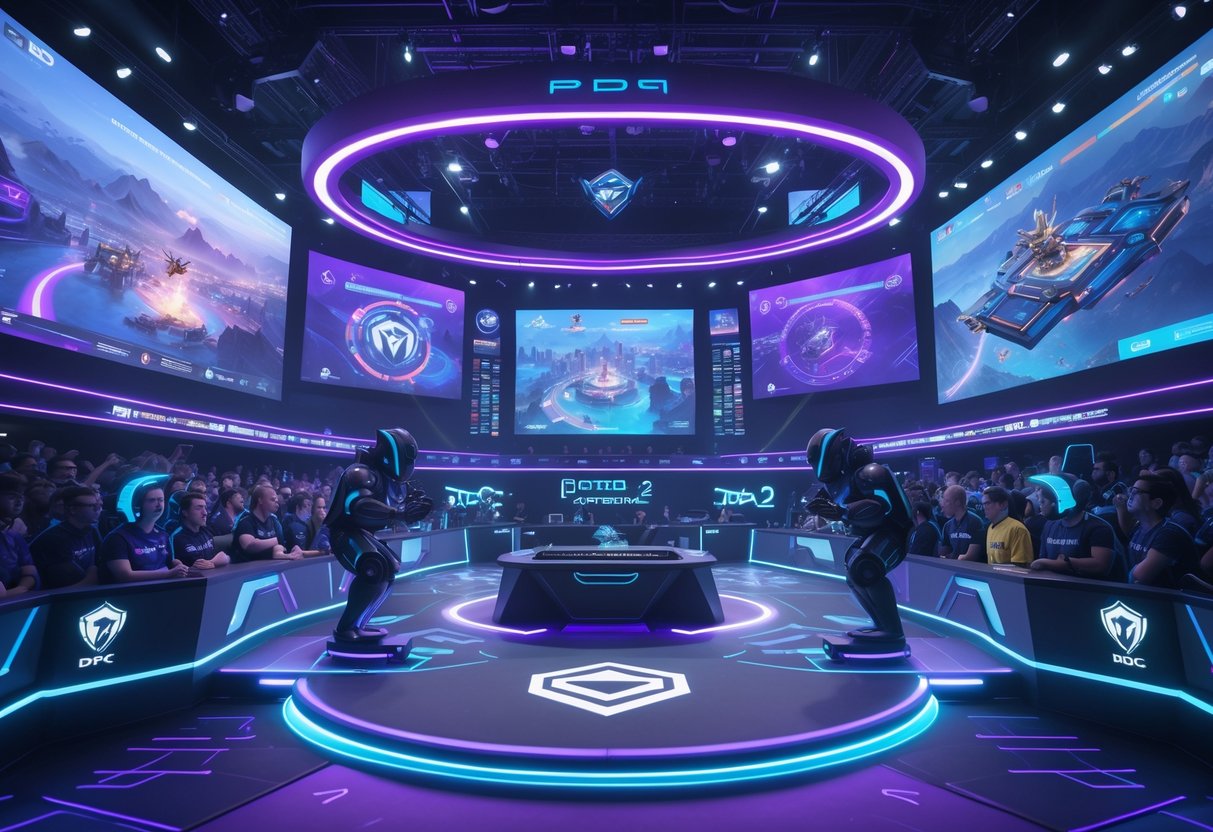
Valve says they’re launching a new competitive system in 2024. It’ll keep merit-based qualification but let tournament organisers do their own thing.
They want to ease the pressure on pro teams and give everyone a clearer path to The International.
Valve’s Promised New Competitive System
Valve announced they’re working on a new framework for 2024. They want to fix the DPC’s biggest problems and keep merit-based competition at the core.
So far, Valve hasn’t shared many details about formats or schedules. They did say teams will get more chances to compete without grinding through endless league play.
What’s promised:
- More transparent International qualification
- Less travel fatigue for players
- Flexible tournament schedules
- Competitive integrity still matters
James Connolly, a gaming expert, points out that Valve likes to test different formats before settling. “We’ve seen Valve iterate on tournament structures before—they prefer gradual refinement over dramatic overhauls.”
We’re all waiting for more specifics, but Valve says they’ll work directly with organisers to shape the new system.
Impact on Tournament Organisers
Tournament organisers now get way more creative control. The DPC used to tie their hands with strict rules on formats, timing, and prize money.
Now, organisers can build events that fit local preferences and work around regional challenges. Maybe we’ll see more weekend cups or longer leagues—who knows?
Organisers get:
- Freedom to set their own schedules
- Room to try new formats
- Direct input with Valve on qualification
- Less red tape
This could breathe new life into regional scenes that struggled under the global DPC setup. Smaller organisers who couldn’t meet DPC standards now have a shot at running qualifiers.
But, there’s a catch. Organisers lose the guaranteed viewers that came with the DPC label. They’ll need to prove their events deserve the spotlight and the best teams.
Merit-Based Competition Commitments
Valve says competitive integrity is still the top priority. Teams have to earn their way to The International by performing well in tournaments—not just by being popular or well-funded.
The merit system means you can’t buy or charm your way into big events. Teams need to show results in sanctioned tournaments.
How the merit system works:
- Results in tournaments decide who goes to The International
- No automatic slots for any team or region
- Rankings are transparent
- Multiple ways to qualify
Some players worry about fairness without the DPC’s point system. Valve will need to balance regional representation and pure performance.
This only works if there are enough good tournaments during the year. Teams need real chances to prove themselves without burning out on travel.
Key Changes to DPC Season Formats
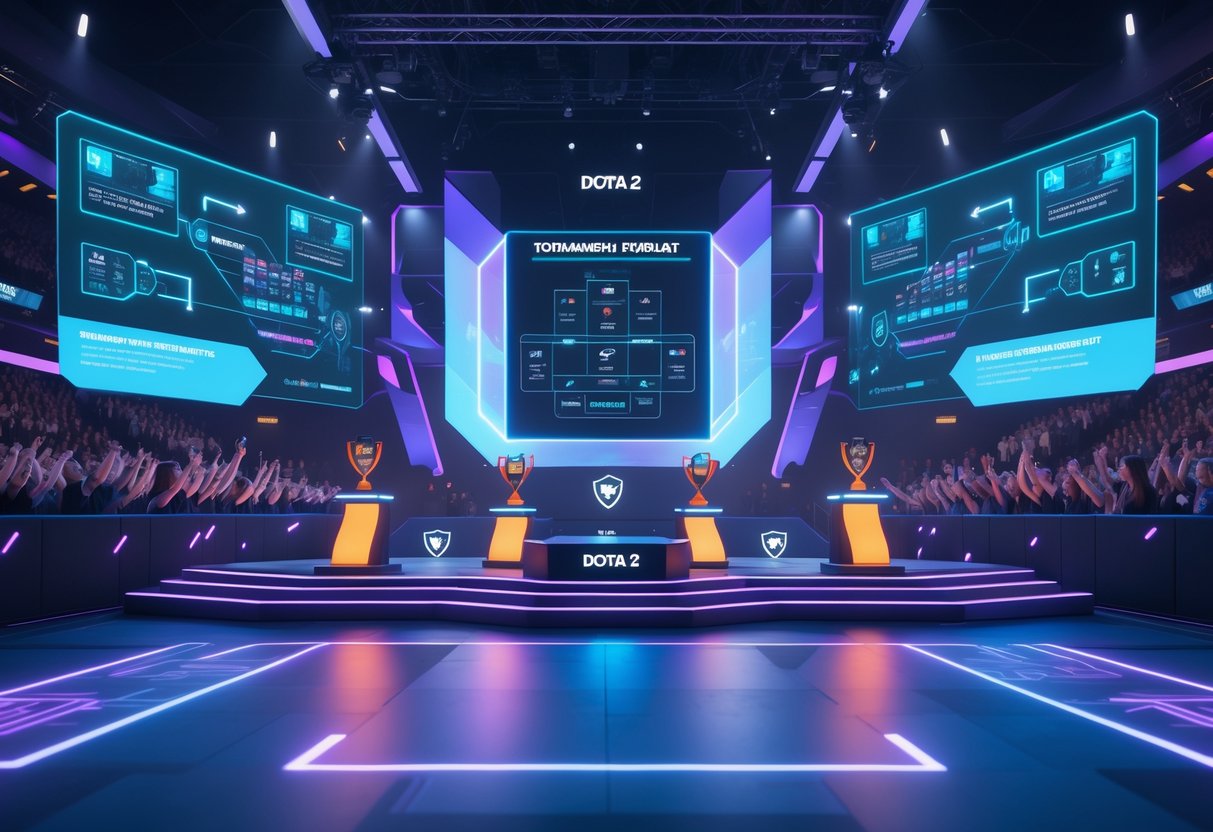
The DPC saw some big structural changes before Valve ended it in 2023. They tweaked tour lengths, division schedules, and regional management to try and cut down on player burnout.
Tour Duration Modifications
In 2023, Valve made the regional league tours shorter—down from eight weeks to just six. Teams ended up with more packed match schedules.
Shorter tours meant:
- Players didn’t have to travel as much
- More breaks between competition periods
- Teams qualified for Majors earlier
Teams had to change how they prepared. Practice got a lot more intense during those six weeks.
The prize pool stayed the same, but Valve spread it across fewer weeks. Every match suddenly meant more.
Upper and Lower Division Scheduling
Valve shook up division schedules in the last DPC seasons. Upper division teams played only best-of-three series. Lower division stuck to best-of-two.
Key scheduling changes:
| Division | Series Format | Matches per Week | Relegation Spots |
|---|---|---|---|
| Upper | Best-of-three | 3-4 series | Bottom 2 teams |
| Lower | Best-of-two | 4-5 series | No relegation |
Upper division teams didn’t have to play as many games per week as before. They used to play up to six series during busy stretches.
Lower division teams felt less pressure. With no relegation, they could focus on getting better, not just surviving.
Regional Tournament Management
Regional leagues got more control over how they ran things. Organisers could schedule matches to fit local time zones and cultural quirks.
Each region could set its own broadcast times. European matches, for example, didn’t have to worry so much about Asian viewers.
Regional autonomy meant:
- Local broadcast partners could get involved more easily
- Prize pools could match what locals wanted
- Qualifiers fit the number of teams in each region
Smaller regions really benefited from these changes. South America and Southeast Asia could finally run tournaments that actually worked for their communities.
Valve ended these experiments after 2023, when they shut down the DPC for good.
Alterations in The International Qualification Process
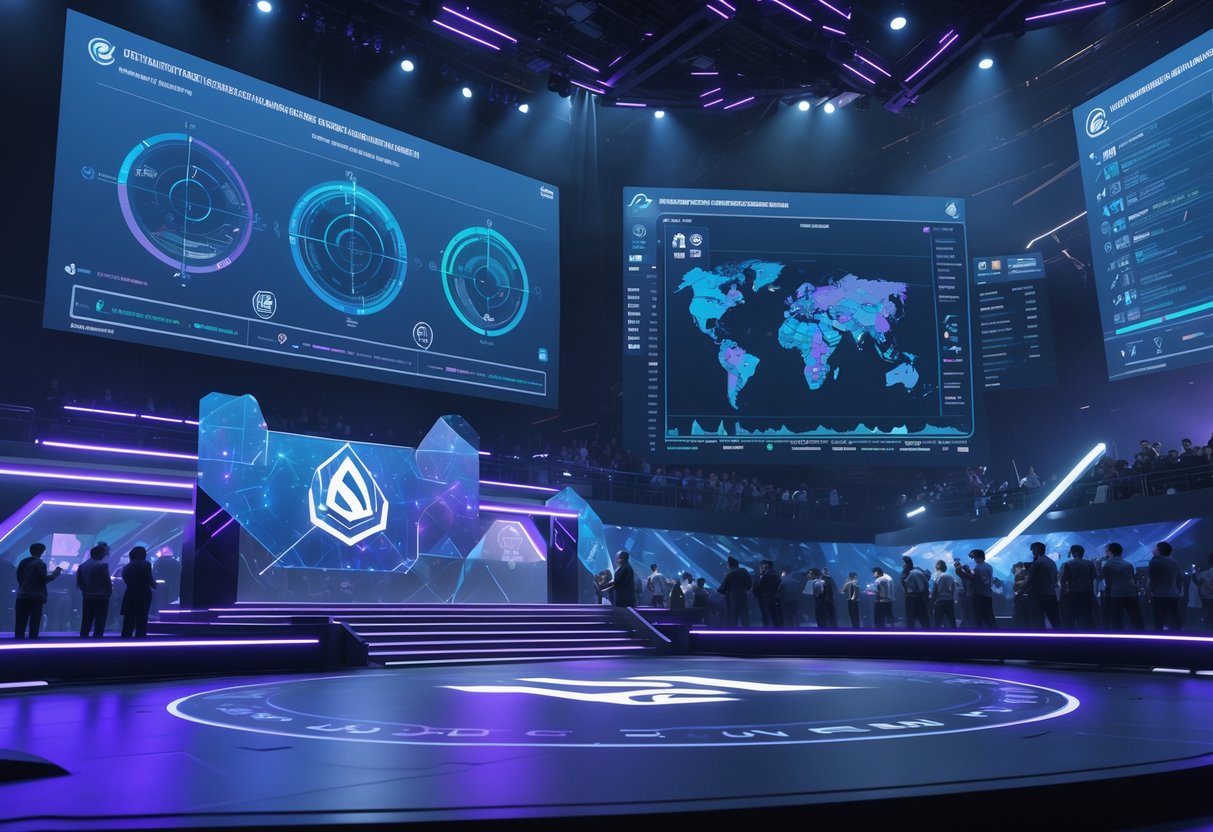
The end of the Dota Pro Circuit totally changed how teams qualify for The International. Valve replaced the old, strict system with more flexible qualification methods and tweaked how many teams can make it.
Old vs. New Qualifying Rules
Before 2024: The DPC System
The Dota Pro Circuit used to lay out a clear path to The International. Teams played in regional leagues all year, and top performers earned points that got them into the world championship.
This system basically worked like a ladder. Teams started in their regions. Winners then moved on to major tournaments.
Success at majors meant more DPC points—and way better chances at The International.
The 2024 Changes
After The International 2023, Valve just scrapped the whole DPC structure. They wanted tournament organisers to have more freedom and flexibility.
The old DPC rules boxed in what tournaments could actually do.
The new system cares more about how teams perform lately. No more year-long point grind. Now, Valve looks at recent results and team strength when inviting teams.
| Old DPC System | New 2024 System |
|---|---|
| Fixed regional leagues | Flexible tournament structure |
| Year-long point system | Recent performance focus |
| Strict tournament rules | More organiser freedom |
| Predictable qualification path | Merit-based invitations |
Community Feedback on TI Spots Allocation
Mixed Reactions from Players
Pro players had all sorts of opinions about the qualification changes. Some liked getting a break from the relentless DPC schedule.
Others? They worried about how unpredictable the road to The International would become.
A lot of teams liked having more downtime for practice between events. The old DPC kept them traveling and competing non-stop.
Fan Concerns About Fairness
Dota 2 fans started questioning if the new system would treat all regions fairly. The DPC at least guaranteed spots for different areas.
Without regional leagues, smaller regions might find it tough to make it to The International.
Some fans got nervous about Valve’s invitation criteria. The DPC points made it obvious who deserved a spot, but now it’s more about Valve’s judgment.
Tournament organisers, though, seemed pretty happy. They finally get to create unique events without all the DPC restrictions.
This freedom should spice things up for viewers.
Roster Changes and Team Dynamics Under DPC Regulations
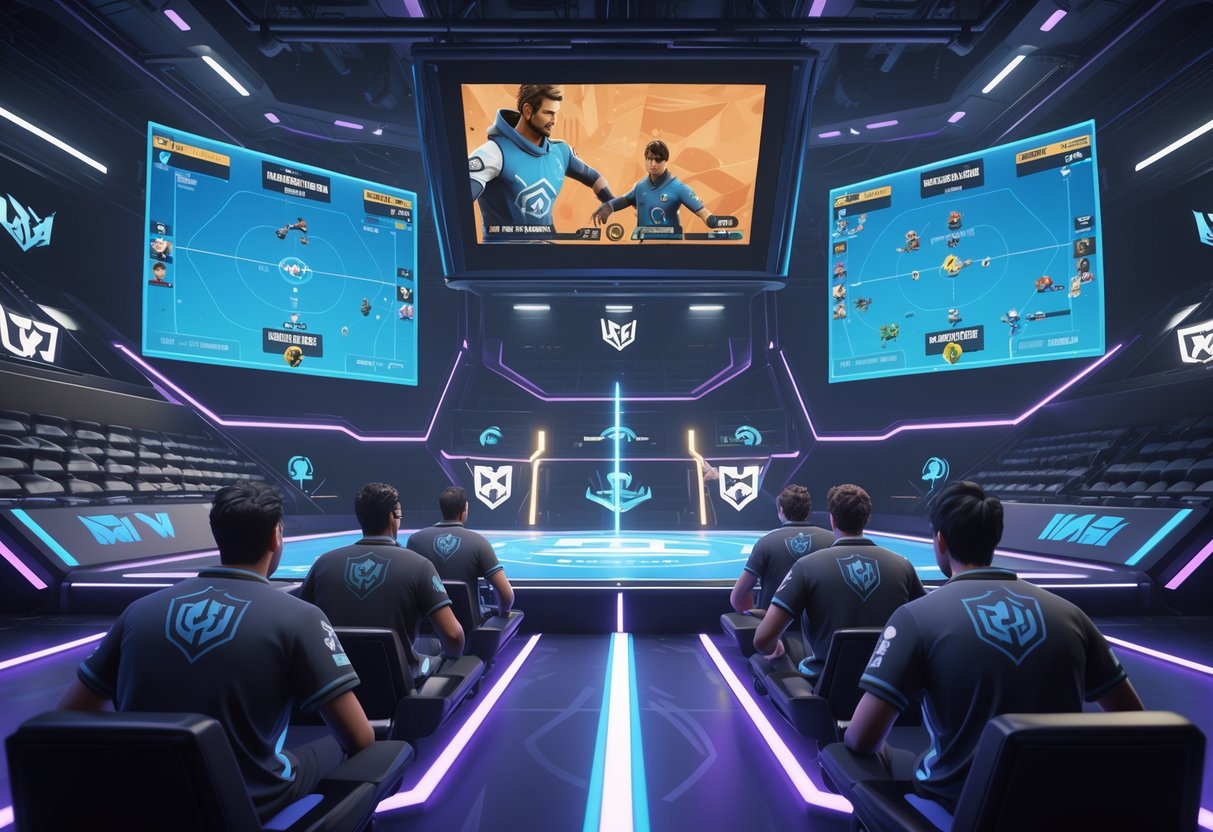
The end of the DPC system has opened up transfer freedom for teams and players. New point decay rules still play a big role in roster decisions.
Teams like Fnatic have had to rethink their approach to roster moves during the competitive season.
Updated Roster Lock and Penalty Rules
Now that strict DPC transfer windows are gone, Dota 2 teams can change rosters whenever they want. Before, transfers only happened during certain periods.
Players and clubs enjoy way more flexibility now. Still, teams need to keep point decay in mind when making changes.
Current Point System:
- Points stay at full value for 16 weeks
- After 36 weeks, they decay completely
- Roster changes instantly trigger point deductions
These penalties force teams to think hard about changes. Too many swaps can wreck their tournament standings and qualification hopes.
Teams often have to balance short-term upgrades with long-term goals. Mid-season adjustments are possible, but there’s always a price.
Notable Off-Season Team Shuffles
Right after The International, teams usually make their biggest moves. This season’s changes really shook up the competitive scene.
- Team Secret brought in Matumbaman to replace Nisha
- Evil Geniuses picked up Abed from Fnatic
- OG rebuilt everything after Ana and Ceb retired
Gaimin Gladiators actually kept their entire TI12 roster together. That’s a bold show of confidence in their team chemistry.
Alliance, Tundra, and other top teams made targeted additions to patch up weaknesses. They’re clearly adjusting to the shifting meta.
The shuffle period opens doors for new talent and gives veterans a shot at fresh teams.
Fnatic’s Team Decisions
Fnatic has handled the new rules by making smart roster moves and investing in player development. They lost their mid laner Abed to Evil Geniuses during the big shuffle.
- Signed 23savage from T1 as new carry
- Released longtime players Moon and DJ
- Doubled down on Southeast Asian talent
Fnatic’s strategy leans toward regional consistency instead of expensive international signings. That fits with the new transfer freedoms and keeps costs in check.
They’re following the wider trend of building sustainable rosters. Long-term development matters more to them than flashy signings.
Their current lineup aims for steady DPC performance rather than making headlines. It’s a measured approach that matches Fnatic’s budget and philosophy.
Point Penalty System for Substitutions and Transfers

The DPC hits teams with point penalties when they swap players or use substitutes during events. Teams lose 20% of their DPC points for mid-season roster changes, and using substitutes at Majors costs 40% of points earned from that tournament per sub.
Penalty Structure for Mid-Season Changes
Every time a team changes a player after roster locks, they lose 20% of their current DPC points. Valve actually raised this from 15% to clamp down on constant roster swaps.
The penalty hits all points the team has at the time. If you’ve got 1,000 DPC points and swap a player, you drop to 800 right away.
Substitute penalties at Majors:
- Teams can use up to 2 substitutes
- Each sub costs 40% of DPC points earned from that Major
- The penalty stacks per substitute, per event
Teams have to think twice about these costs. A Major might give 500 points, but use a sub and you’re down to 300.
Implications for DPC Points and TI Eligibility
These penalties can make or break a team’s shot at The International. High DPC rankings are everything for direct invites, so every point counts.
Mid-season swaps can ruin a team’s TI chances. A team sitting 8th could drop to 12th after one roster change and miss out completely.
Timing matters a lot:
- Early season changes hurt less since there are fewer points at stake
- Late swaps can kill TI dreams
- Emergency subs might save a tournament but cost crucial points
Teams now plan roster moves around the DPC calendar. They prefer to change lineups in the off-season to dodge point losses.
Registering substitutes is a careful process. Sometimes using a stand-in for illness helps in the short term but could cost a spot at The International.
Tournament Organiser Freedom and Regional Shifts

Valve’s old guidelines boxed in tournament organisers, limiting how creative they could get. Ending the DPC also meant big event companies started pulling back from regional divisions.
Changes in Hosting Rights
The DPC system forced organisers to follow strict rules, right down to format and broadcast requirements.
Organisers couldn’t really try out new formats. Prize pools and qualification systems were basically set in stone.
Key restrictions:
- Fixed tournament formats
- Required regional coverage
- Broadcast rules with little wiggle room
- Tight scheduling
Now, organisers have way more control. They can tweak formats and rules to fit their own audience.
This freedom is already leading to more creative tournament structures. We’re seeing new ways to qualify and different prize pool splits.
But there’s a trade-off: less standardisation. Every tournament might run on different rules now.
Departure of Major Event Organisers
When Beyond The Summit announced they’d stop hosting a regional DPC division in 2023, it was a big deal.
BTS had been a staple in Dota 2 esports for years. Their exit raised questions about whether the DPC format could last.
Impact on regional coverage:
- Less coverage in some regions
- New organisers stepping in
- Changes in broadcast quality
- Shifts in tournament schedules
Losing established organisers left some regions scrambling. New companies had to fill the gaps.
This transition period led to inconsistent regional competition. Organisers brought different production levels and management experience.
Some regions struggled with the new hosting setups. Players and fans had to get used to new broadcast styles and formats.
Community and Pro Player Reactions
The DPC changes split the Dota 2 community right down the middle. Most pro players were thrilled, but casters and managers got worried about job security and the future of the competitive scene.
Mixed Reception Among Stakeholders
Pro players mostly cheered the end of the DPC. Johan “N0tail” Sundstein, Dota 2’s top earner, called it the “best thing that happened to Dota in a long time.”
Andreas “Cr1t-” Nielsen liked Valve’s recent decisions and said their communication had improved. Team Liquid’s Aydin “iNSaNiA” Sarkohi agreed, and OG coach Mikhail “Misha” Agatov looked forward to “a more fun pro scene.”
Talent and casters had mixed feelings. Analyst Murielle “Kips” Huisman admitted the DPC was “monotonous,” but worried about going back to old formats without enough community support.
Caster Austin “Cap” Walsh wanted more third-party tournaments but worried about event organiser diversity. He hoped for “more Summits, Midas Modes, AniMajors”—tournaments that make Dota 2 more fun for everyone.
Concerns About Competitive Integrity
Job security became a real concern for broadcast talent. Caster Robnroll said the DPC was his only steady work and feared there wouldn’t be enough events for smaller teams and talent.
Bkop echoed this, saying the “job security that came with it” would vanish after the DPC.
Team managers had bigger worries. Entity’s manager Noah posted about the sudden changes affecting people’s livelihoods. He felt the DPC helped new players grow and kept the team scene diverse.
The Dota 2 esports world now faces a lot of uncertainty. Without set tournament structures, some people fear the scene could turn into a “Wild West.”
Optimism for Flexible Scheduling
Alliance founder Jonathan “Loda” Berg loved the return to “the good old days” of event organisation. Many pros shared his excitement for flexible formats.
Players are looking forward to more creative tournament formats instead of the rigid DPC.
The community wants open qualifiers and event styles that made Dota 2 exciting in the past.
Third-party organisers now play a bigger role in shaping the scene. This could make tournaments more varied, but it also brings some uncertainty about how consistent opportunities will be for all teams.
Case Studies: Impact of DPC Changes on Notable Teams
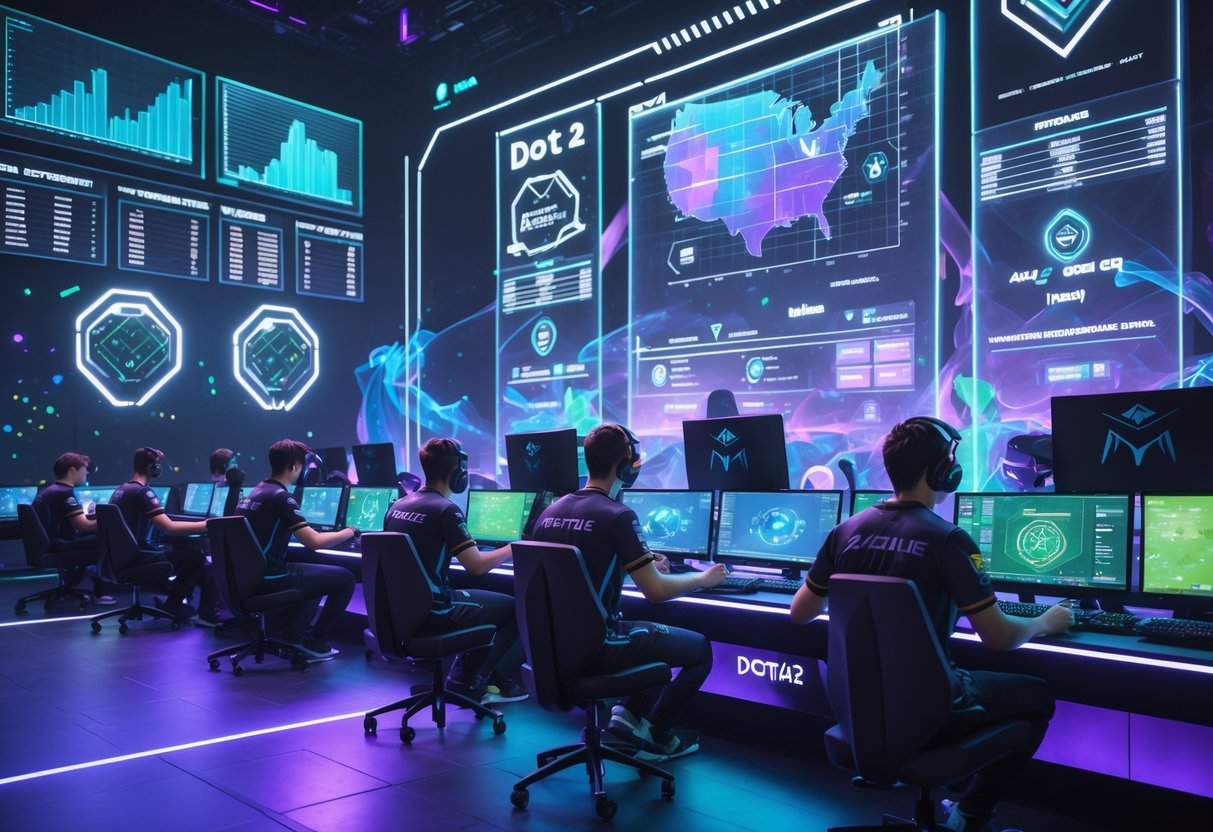
The DPC overhaul really shook up the pro scene. Teams like Fnatic struggled to adjust to the new qualification format, while others managed to adapt surprisingly fast.
Examples from The International 2022
The International 2022 really showed how the DPC changes shook up team performance. Fnatic probably felt the impact more than anyone.
The Malaysian org’s roster just couldn’t find their footing with the new regional format. They ended up near the bottom in Southeast Asia’s DPC league and missed out on automatic TI12 qualification.
Fnatic had to take their chances in the last chance qualifiers. A team that used to dominate SEA Dota 2 suddenly had to fight for every scrap. Their main lineup just didn’t click with the faster-paced league schedule.
Some teams actually thrived under the new system. TSM grabbed their first major tournament spot thanks to the revamped point system. The North American squad got more chances to prove themselves internationally.
Entity surprised everyone by qualifying from Western Europe. The new format finally let smaller organisations break through. Before this, big names ruled the scene every year.
Major Roster Moves Pre- and Post-DPC Update
Roster changes sped up a lot after the DPC format announcements in early 2022. Teams scrambled to put together lineups that could survive the new system.
Fnatic made some of the boldest moves in Southeast Asia. They swapped out three core players in just six months. The org hoped new faces would handle the league pressure better.
European teams did things differently. Team Secret stuck with their roster at first. Eventually, though, they made changes when their DPC results didn’t improve.
Chinese teams like PSG.LGD went for consistency. They focused on tactical tweaks instead of swapping out players. This approach helped them stay solid in regional leagues.
Teams with strong coaching infrastructure had a real edge in the new DPC. Orgs started pouring resources into support staff instead of just chasing star players. That shift totally changed how teams built their rosters.
Comparing the DPC Era with Previous Competitive Structures
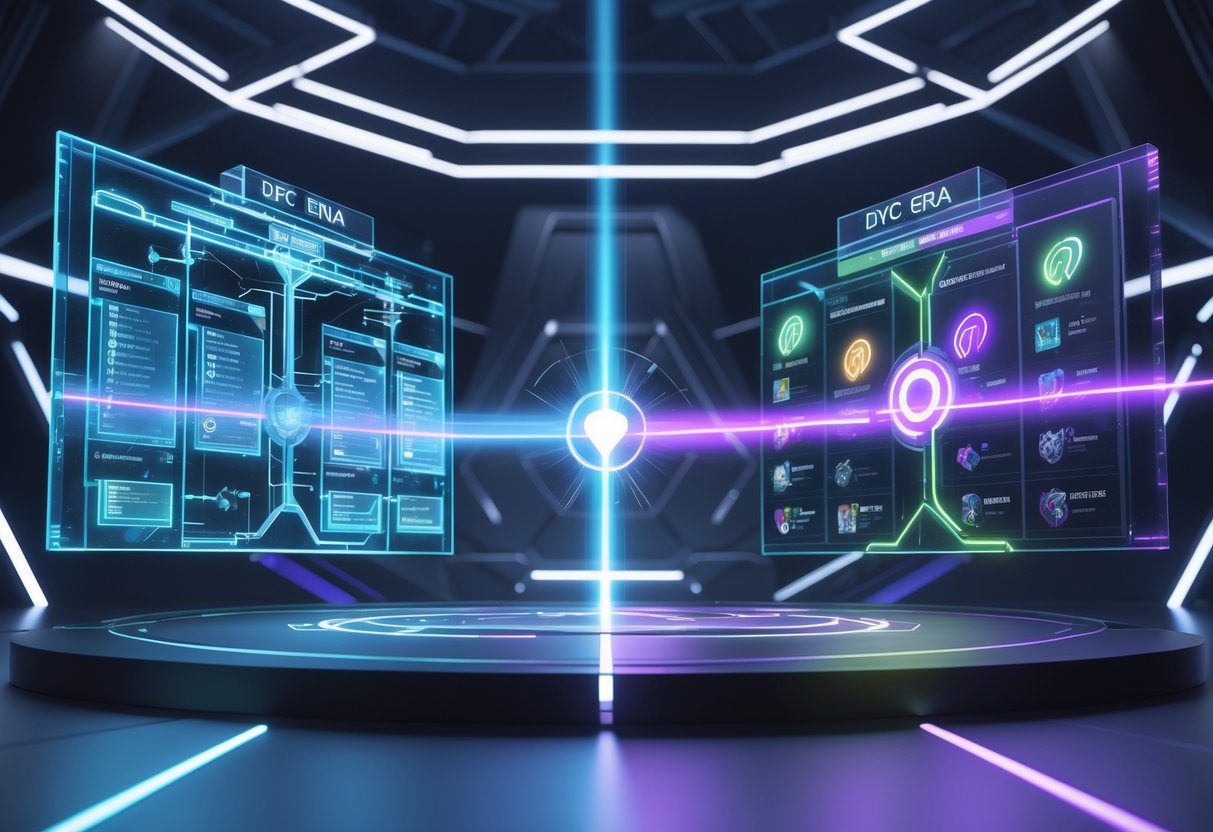
The DPC system really flipped things from Dota 2’s early, wild-west tournaments to a much more structured league setup. Both approaches shaped the game in their own ways, for better or worse.
Advantages and Drawbacks of Each System
Pre-DPC Era (2011-2017)
The original tournament scene thrived on variety and a bit of chaos. Organisers like Beyond The Summit put together events with quirky formats. Teams would travel all over for different tournaments, and each event had its own vibe.
| Advantages | Drawbacks |
|---|---|
| Creative tournament formats | Inconsistent player income |
| Multiple organisers competing | No guaranteed path to TI |
| High production innovation | Travel burnout for teams |
| Fan engagement through variety | Regional imbalances |
Tournaments like The Summit and ESL became iconic during this time. Still, a lot of players struggled with money between events.
DPC Era (2017-2023)
The DPC brought in stability, with guaranteed prize pools and clear qualification paths. Regional leagues kept the tier-2 scenes alive, so up-and-coming players got more chances.
| Advantages | Drawbacks |
|---|---|
| Stable player salaries | Limited tournament variety |
| Clear TI qualification system | Reduced organiser creativity |
| Global tier-2 support | Lower broadcast quality |
| Structured competitive calendar | Fan viewership decline |
Teams always knew what it took to reach The International. On the flip side, many fans thought the league format just felt repetitive compared to the excitement of knockout events.
Long-Term Outlook for Dota 2 Esports
Post-DPC Opportunities
It looks like Dota 2 is heading back to a tournament-heavy model, kind of like CS. ESL Pro Circuit events are already showing this shift, and the Riyadh Masters is putting up a wild £11.5 million prize pool.
If Valve brings back crowdfunding, independent organisers might make a comeback. That could mean a return for creative formats like Midas Mode or Captain’s Draft—stuff that vanished during the DPC era.
Potential Risks
Some smaller organisers shut down or changed direction during the DPC years. WePlay moved because of the Ukraine war, and Beyond The Summit just closed shop.
If ESL FACEIT Group becomes the only big organiser, things could get pretty samey. That might kill off the variety that made early Dota 2 so much fun.
Regional Considerations
Tier-2 regions might have a rough time without the DPC’s guaranteed prize pools. Places like South America and Southeast Asia could struggle if there’s no solid support structure.
Valve’s next moves for regional leagues will decide if new players can still climb up to the pro scene.
Frequently Asked Questions
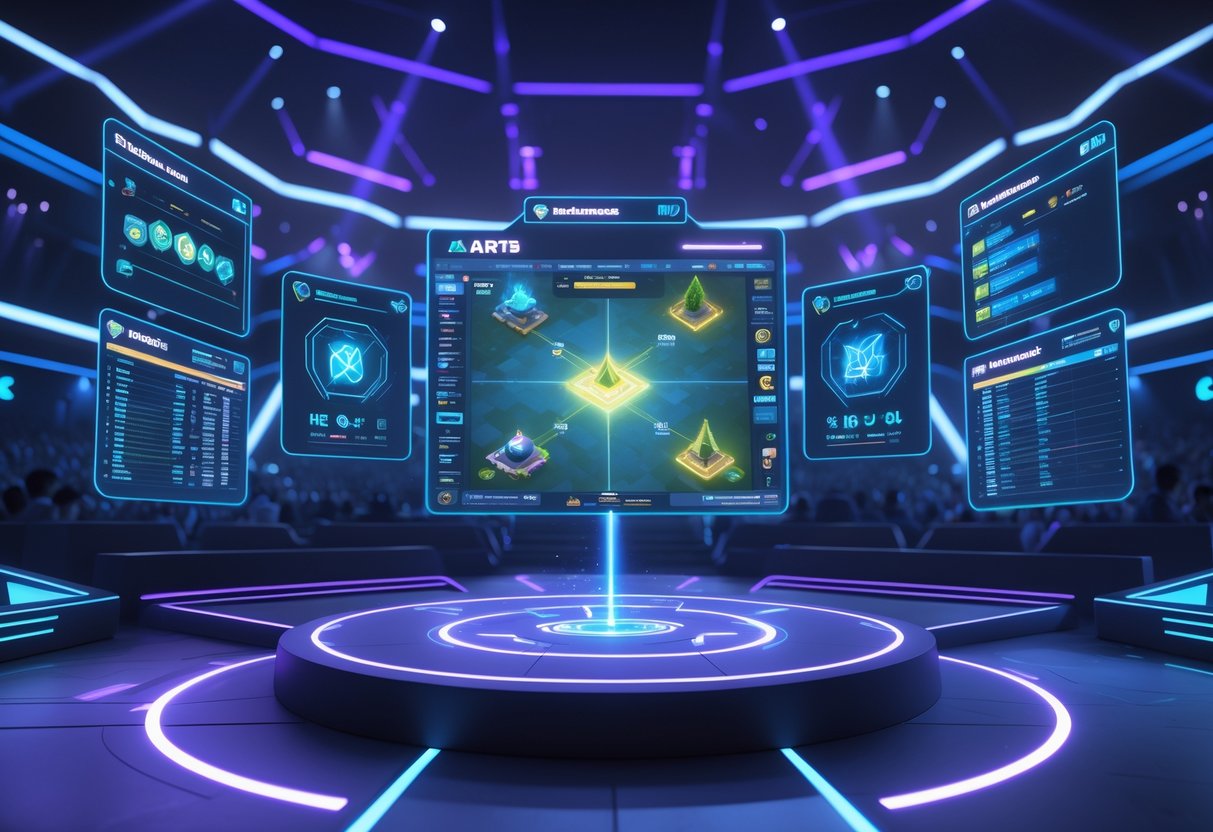
The DPC system ended for good after the 2023 season. Now, Valve has switched to a more flexible tournament setup. Organisers get more freedom, but teams still qualify for The International based on merit.
What are the latest updates to the DPC point system for the current season?
There’s no DPC point system anymore. Valve scrapped the whole Dota Pro Circuit after 2023.
No more updates are coming, since the system doesn’t exist. Teams now have to qualify for The International through a new process that started in 2024.
Quick win: Keep an eye on Valve’s official announcements for details on the new qualification system.
How does the new DPC structure affect team standings and qualifications?
There’s no DPC structure left at all. Valve ended it to take some pressure off teams and give organisers more freedom.
Now, everything’s about merit-based competition. Teams still fight for TI spots, but they do it through different tournaments and new qualification methods.
Organisers can design their own events. Teams have to deal with a totally different competitive landscape compared to the old DPC schedule.
Can you explain how the points are distributed in pro matches following the recent changes?
Points aren’t distributed anymore since the DPC system got cancelled. The point-based qualification that ran from 2018 to 2023 is gone.
Valve’s new plan doesn’t use points. Teams qualify by playing in tournaments that organisers set up however they want.
Warning: Some websites still list old DPC point data, but that’s all outdated now.
What impact do the DPC changes have on the rankings for international tournaments?
The main thing is, there aren’t any DPC rankings now. Teams don’t collect points through the year to lock in a spot at The International.
Valve’s new system is supposed to be more transparent. It tries to fix complaints about the old DPC’s confusing qualification process.
Organisers can create their own formats and qualification paths. This should give teams more ways to reach the top.
How frequently are the DPC rankings updated, and where can they be accessed?
DPC rankings don’t get updated anymore. The last ones were from 2023, right before Valve pulled the plug.
If you want to check old DPC data, sites like Liquipedia still have it. But it’s only good for looking back at previous seasons.
Quick win: For current results, just follow tournaments on Dotabuff or catch live games on Twitch to see which teams are hot right now.
What are the significant differences in the DPC format compared to last year?
Honestly, the biggest change is that the DPC format just doesn’t exist anymore. Valve scrapped the whole system instead of tweaking it.
Last year, teams had to play in regional leagues and Majors, picking up points as the season went on. Now, tournament organizers get to decide everything—event formats, how teams qualify, all of it.
Before, teams found themselves traveling all the time and dealing with a really strict schedule. With this new direction, that pressure’s gone, and organizers can experiment with different tournament styles.

